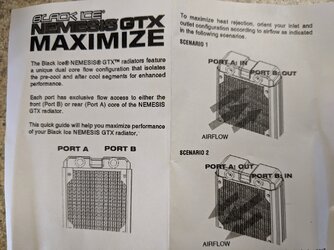- Joined
- Jun 21, 2002
My Nemesis GTX radiator came with this insert:

The radiator has a front and rear core, if you're looking at it head on towards the ports we'll call that the front. Instead of a left and right half with a U flow at the end, the coolant will flow across the entire width or the radiator but only half the thickness (say the back half), and once it reaches the end tank, it will flow back across the entire width of the radiator through the front half.
In the picture above, with front to back airflow, it is advised to flow coolant first through the back of the radiator (port A) and then through the front of the radiator to exit via port B. My understanding would be that the front chamber acts as an after-cool and the rear as a pre-cool. So air is that is case ambient is encountering coolant that has made one pass through the radiator. Air that has been warmed by passing through the front chamber then passes through the rear chamber, hopefully extracting more heat.
I'm extrapolating that the principle here is that warmer air should contact the coolant first (in terms of loop order), and cooler air should be last. The implication is that the coolant temperature will be different between passes in the radiator. If water fresh off of the components contacted case-ambient air and warmed it up, then in the second pass the delta T between the coolant and air as it flows through the rad would be decreased, compared to the advised configuration.
This contradicts the conventional wisdom that loop order doesn't matter because water temperature will be equalized. If water temperature was unchanged during passes, then the delta T would be decreased for the second pass by the same amount, regardless of which way the water flowed through the rad. If this were the case, I doubt that HWLabs would have placed this insert into their product packaging.
I can fully understand that the difference might not be significant when we're dealing with a component to coolant delta T of 30C - 60C (the coolant having a high enough specific heat that a minor difference in coolant temperature is not relevant to performance), but may make a difference when dealing with a coolant to air delta T of 10C - 20C. If your delta T is 10C, then a 1C difference is 10% and a 3C difference is 30%, meanwhile if your CPU is 70C and your coolant is 35C, a 1C increase is < 3%.
Do you guys agree with HWLabs? Or did they go to the trouble of including that for nothing?
Do you think this principle applies to using multiple rads in a case as well, as intake and exhaust (such that the intake rad is after the exhaust rad in loop order)?

The radiator has a front and rear core, if you're looking at it head on towards the ports we'll call that the front. Instead of a left and right half with a U flow at the end, the coolant will flow across the entire width or the radiator but only half the thickness (say the back half), and once it reaches the end tank, it will flow back across the entire width of the radiator through the front half.
In the picture above, with front to back airflow, it is advised to flow coolant first through the back of the radiator (port A) and then through the front of the radiator to exit via port B. My understanding would be that the front chamber acts as an after-cool and the rear as a pre-cool. So air is that is case ambient is encountering coolant that has made one pass through the radiator. Air that has been warmed by passing through the front chamber then passes through the rear chamber, hopefully extracting more heat.
I'm extrapolating that the principle here is that warmer air should contact the coolant first (in terms of loop order), and cooler air should be last. The implication is that the coolant temperature will be different between passes in the radiator. If water fresh off of the components contacted case-ambient air and warmed it up, then in the second pass the delta T between the coolant and air as it flows through the rad would be decreased, compared to the advised configuration.
This contradicts the conventional wisdom that loop order doesn't matter because water temperature will be equalized. If water temperature was unchanged during passes, then the delta T would be decreased for the second pass by the same amount, regardless of which way the water flowed through the rad. If this were the case, I doubt that HWLabs would have placed this insert into their product packaging.
I can fully understand that the difference might not be significant when we're dealing with a component to coolant delta T of 30C - 60C (the coolant having a high enough specific heat that a minor difference in coolant temperature is not relevant to performance), but may make a difference when dealing with a coolant to air delta T of 10C - 20C. If your delta T is 10C, then a 1C difference is 10% and a 3C difference is 30%, meanwhile if your CPU is 70C and your coolant is 35C, a 1C increase is < 3%.
Do you guys agree with HWLabs? Or did they go to the trouble of including that for nothing?
Do you think this principle applies to using multiple rads in a case as well, as intake and exhaust (such that the intake rad is after the exhaust rad in loop order)?